
In this case, the letters indicating hammer-ons and pull-offs will not be displayed in the tablature. Thus, bass note stems will be displayed downwards and treble note stems will be displayed upwards. If the note stems have not been forced, the 3rd string open G (G1) is used to determine whether a rest is upper voice or lower voice.Ĭontrols the direction used for note stems in the tablature.Ĭauses all stems to be displayed downwards from the numbers in the tablatureĬauses all stems to be displayed upwards from the numbers in the tablatureĬauses the note stems in the tablature to be displayed with the same orientation as those in the stave. To get the best results, you should force stems upward for the upper voice and stems downward for the lower voice. If check marked, it will insert rests automatically for the upper (melody) and lower (bass) voices. Automatic rests highlight placement and duration errors when entering notes thus providing an effective method of verifying corrections within the score. The " X2" option allows the management of automatic rests for two voices. These automatic rests will also be printed out in both the notation and the tablature if the " Rests in Tablature" option in the Printing options dialog is selected. This option allows the display of the rests automatically deduced by TablEdit from the position and duration of the notes in each measure in the notation. It has no effect on actual MIDI playback which will follow the entries of the Reading List in either case. This option controls whether the " reading guides" deduced from the " Reading List" are displayed or not. The "Chord Editor" in TablEdit, although not completely without fault from the user's point of view, provides you with a highly advanced tool for creating your own diagrams.Ĭlicking on an automatic chord diagram opens the "Chord Editor" dialog, allowing you to modify the diagram and add it to the list in the Chord Manager. One is to create and name custom chords of your own and the other is to use custom chords which have been included in other tablatures or collected into custom chord catalogs. Given the fact that any given three note combination (the minimum number of notes required to name a chord) will usually have at least two correct chord names there is also the problem of whether a barré chord is, for example, an A or a G (enharmonic chords). The same applies to the chord names assigned to various diagrams. If it only has two or three notes to work with, I can guarantee you that any program is going to end up showing an incorrect chord at least half the time. This isn't the fault of the programmer, it's just that the algorithm can only deduce chord positions from the notes actually entered by the user. In fact, by its very nature, an automatic computer algorithm cannot be expected to treat even common chords correctly under all possible circumstances. In this case, automatic chord diagrams will neither be displayed on the screen nor included on your printouts.Īlthough TablEdit's automatic chord function is relatively advanced, it cannot always handle the positions necessary to a particular arrangement. If you're not satisfied with the result, you can disable the option. This may help you to rapidly determine the most convenient left hand fingering to use.

TablEdit then attempts to identify the chord and, if successful, displays its name underneath the diagram. If it succeeds, it automatically displays a chord diagram above the location concerned. TablEdit analyzes the fingerings in the tablature and attempts to recognize the chord positions it finds. Certain licks may require the use of specific, often unorthodox, chord shapes.


The chord positions used in an arrangement are directly related to the playability of the piece. The settings made here affect both the on-screen appearance and your printouts. The " Display" tab allows you to define the display of chord diagrams, note stems, endings, repeats, etc.


 0 kommentar(er)
0 kommentar(er)
